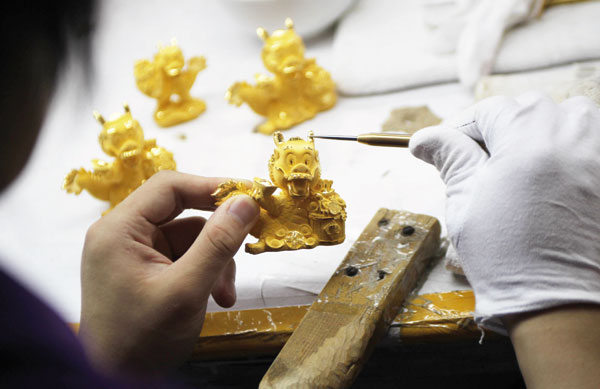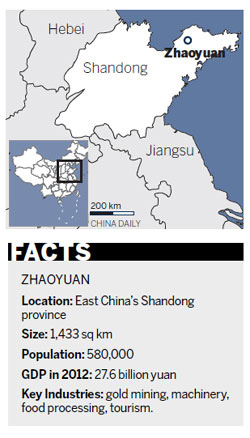All that glisters is no longer gold in Zhaoyuan
Updated : 2013-10-21
By Zhong Nan and Zhao Ruixue (China Daily)
|
 A worker carves a gold ornament in Zhaoyuan. As the gold capital in China, Zhaoyuan now realizes that it should plan the resource carefully and diversify gold-related industries. [Photo / Xinhua]
|
Mining hub seeks other ways to turn an honest penny as reserves of precious metal start to decline
China's gold capital, Zhaoyuan, used to be the very model of optimism. As the country basked in economic success and the city in Shandong province faced the possibility of stiffer economic competition from its neighbors, there was always a loud chorus of reassurance: "Our gold-filled mines will always keep us ahead."

But the shaky premises on which that hope was built have begun to dawn in Zhaoyuan as the price of gold has fallen this year and as it has become clearer that the city's gold mines are not bottomless.
Now the government and gold mining companies are diversifying their business models to ensure that economic fortune continues to shine on Zhaoyuan.
The city has 68 gold mines with explored reserves of about 520 tons and produced 33 tons of gold last year, accounting for one-seventh of the country's total annual gold output. Thanks mainly to gold, Zhaoyuan has been ranked as one of China's 100 fastest growing county-level cities for 38 years.
"There is great scope for gold to support the country's growth," says Zhao Bingxu, director of Zhaoyuan's gold industry management bureau. "However, it's possible that Zhaoyuan's gold reserves will dry up in the next 10 to 15 years if all mining companies continue to carry on large-scale exploitation."
To help the city confront the challenges posed by exhausted mines, mining companies have started recycling abandoned low-grade ore or digging more deeply to eke out more from mines whose years are numbered.
Zhao says most gold mines in Zhaoyuan used to extract ore that contained about 4 grams of gold a ton, but with heightened demand that has been reduced to 2 grams a ton. That exhaustive production is said to have been detrimental to both mines and the environment.
"The city clearly needs more measures to put its economic growth on a healthy footing because revenue from gold mining is highly likely to fall amid unstable international gold prices and economic uncertainties in the West," Zhao says.
"It costs about 105 yuan ($17) to produce one gram of gold," says Lu Dongshang, president of Shandong Zhaojin Group Co Ltd, China's largest gold producer and one of the world's 20 largest.
"But costs have already risen about 8 percent this year because of rising mining equipment, power and labor costs."
Whereas the State-owned China National Gold Group Corp is keen on buying gold mines overseas such as Goldcorp Inc of Canada or Newcrest Mining Ltd of Australia, even though the price of gold approached a low point of $1,200 an ounce this year. Zhaojin Group has started to prospect and develop gold, silver and copper mines in other Chinese provinces to ensure its production capacity.
